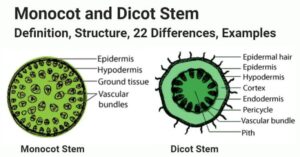Back to: Botany 300 Level
Hello, my brilliant friend! I hope you’re having a great day! Have you ever pulled out a young plant and noticed the different structures in its roots? Some plants have thick, strong roots, while others have thin, fibrous ones. This is because of differences in the anatomy of dicot and monocot roots. Today, we’ll explore how these two root types are structured and why they function differently.
Anatomy of dicot and monocot roots
What Are Monocot and Dicot Roots?
Plants are divided into monocots (e.g., maize, rice, palm) and dicots (e.g., mango, hibiscus, beans) based on the number of cotyledons (seed leaves) in their seeds. This classification also affects their root structure.
Dicots usually have taproots – a single main root with smaller branches.
Monocots have fibrous roots – many thin roots growing from the base of the stem.

Let’s now look at their internal structure (anatomy)!
Anatomy of a Dicot Root
Dicot roots have a well-organised vascular system (xylem and phloem arranged in a ring). The layers of a dicot root, from outer to inner, are:
Epidermis – The outermost layer that protects the root.
Cortex – A thick layer made of parenchyma cells that stores food.
Endodermis – A single layer of cells that controls water flow into the vascular tissues.
Pericycle – The layer inside the endodermis where lateral roots develop.
Vascular Bundle (Xylem and Phloem) – Arranged in a cross (X-shape) in the centre.
Xylem (water transport) is in the centre.

Phloem (food transport) is between the xylem arms.
This arrangement makes dicot roots strong and deep-growing, perfect for anchoring large plants.
Anatomy of a Monocot Root
Monocot roots also have similar layers but with some key differences in their vascular arrangement. The layers include:
Epidermis – A protective outer layer.
Cortex – A large storage region made of parenchyma cells.
Endodermis – Controls water movement into the vascular tissues.

Pericycle – Forms lateral roots.
Vascular Bundle – Unlike dicots, xylem and phloem are arranged in a ring rather than an X-shape.
Pith – A central region filled with soft parenchyma cells (absent in dicots).
This arrangement helps monocots spread out their roots in the soil, making them great for absorbing water from a large area.
A Simple Story to Understand This Concept
Imagine two friends planting crops: one plants a mango tree, and the other plants maize. The mango seedling grows deep and strong with one big root (taproot), helping it stay firm even in strong winds. But the maize plant spreads out many thin roots (fibrous roots) to absorb water quickly. This is the difference between dicot and monocot roots!
Summary
Dicot roots have a taproot system, with xylem in an X-shape in the centre.
Monocot roots have a fibrous root system, with vascular bundles arranged in a ring.
Dicot roots support deep anchorage, while monocot roots absorb water from a wide area.
Monocots have a large pith, while dicots do not.
Evaluation
- What is the main difference between dicot and monocot root systems?
- How is xylem arranged in dicot roots?
- What is the function of the pericycle?
- Why do monocot roots have a large pith?
- Which root type is better for deep anchorage, and why?
You are doing an amazing job! Now, when you see a mango tree and maize plant, you’ll know exactly how their roots are different! Keep learning with Afrilearn, and I’ll see you in the next exciting lesson. Stay curious and keep growing!
